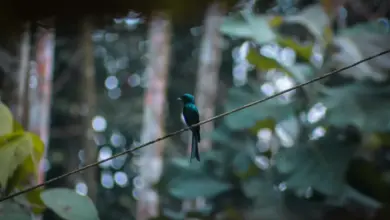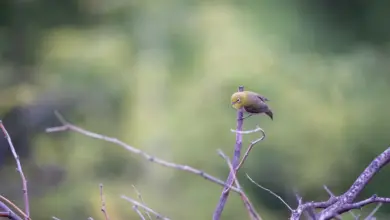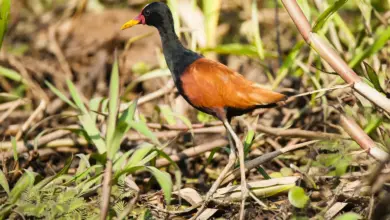Long-trained Nightjars
The Long-trained Nightjars (Macropsalis forcipata formerly Macropsalis creagra) is a South American nightjar.
This nightjar is commonly heard within its range, but less often seen – due to its nocturnal habits. Its brown-mottled plumage keeps it well camouflaged during the day, when it is also usually hidden away sleeping.
The cryptic appearance of these nightjars allows them to blend perfectly into their habitat and they are very difficult to spot during the daytime, when they are usually hidden away sleeping.
These birds are most easily detected at night when light from car headlights are reflected red from their eyes, as they are sitting on tracks or roads. However, their presence is most often made known by their loud calls given at dusk.

Torpor (temporary hybernation) in winter is possible.
Distribution / Range
The Long-trained Nightjars is native to:
- southeastern Brazil, where it occurs in Espírito Santo, Rio de Janeiro, São Paulo, Paraná, and Rio Grande do Sul; and possibly in Minas Gerais and Santa Caterina.
- Northeastern Argentina, where it is found in the Misiones province.
Its preferred habitat includes subtropical or tropical moist montane forests.
Description
The Long-trained Nightjars is a medium-sized nightjar. Males average 28 – 30 inches (70 – 77 cm) in length, including the long tail. The female has a shorter tail and only averages 10.6 – 11 inches (27 – 28 cm) in length.
The plumage is dark with a cinnamon-rufous half-collar and pale yellow-brown colored throat.
The male has greatly elnogated outer rectrices (tail feathers) which are mostly white on the inner web.
The female has a much shorter, forked tail.
Similar Species:
The only other nightjar species with a long-tailed male is the Scissor-tailed Nightjar – however, this species is much smaller and has a crown streaked with black, not dotted.
Alternate (Global) Names
Czech: Lelek lyroocasý, lelek vle?koocasý … Chinese: ???? … Danish: Sakshalet Natravn … Dutch: Braziliaanse Nachtzwaluw … German: Hackenschwanz-Nachtschwalbe, Hakenschwanz-Nachtschwalbe, Scherennachtschwalbe … Spanish (Argentine): Atajacaminos coludo, Atajacaminos coludo grande … Estonian: vedik-öösorr … Finnish: Laahuskehrääjä … French: Engoulevent à traîne … Italian: Succiacapre coda a strascico, Succiacapre paggetto … Japanese: nambeionagayotaka, nanbeionagayotaka … Norwegian: Slepnattravn … Polish: Dziwoletek trenowy, dziwolotek trenowy … Portuguese: bacurau-tesoura, bacurau-tesoura-gigante, curiango-de-cauda-longa, curiango-tesoura, Curiango-tesourão … Russian: ??????? ??????????? ???????, ??????????? ??????? … Slovak: lelek vleckový … Spanish: Atajacaminos coludo, Atajacaminos coludo grande, Chotacabras Coludo, Dormilón Tijereta… Swedish: Släpnattskärra
Nesting / Breeding
The male establishes his territory and sings at night to keep rivals away and at the same time to attract a female.
Nightjars don’t actually construct a nest, as most other bird species do. They simply place the eggs on the ground on open soil covered with dead leaves.
Nesting appears to be timed in such a way that the moon is more than half full at the time they are feeding their young – likely as the additional light during the night facilitates caring for the young and foraging for food.
The female may lay one to two eggs (mostly two) that are whitish or creamy in color, with brown and grey spots or blotches.
During the day, the incubation of the eggs is undertaken by the female, while both parents share the incubation at night. The incubation period is about 19 to 21 days.
The down-covered young are capable of short-distance movements within 24 hours of hatching. The male usually stands guard and defends the nest and the young. He will hover in place near the nest with his body in a nearly vertical position. Both parents communicate with their young via soft clucking sounds to which the chicks respond.
They feed their young regurgitated food (insects), and they continue to brood them until they fledge. The chicks take their first flight when they are about 20 to 21 days old.
If conditions are favorable, the female may lay a second clutch close to the first and while she is incubating the new set of eggs, the male continues to care for the young from first brood.
They have developed several behavioral adaptations to minimize predation:
- Their nocturnal (night) lifestyle reduces the likelihood of being detected by daytime predators. During the daytime, they typically sleep on the ground where they are perfectly camouflaged by their “earthy” colored plumage. They almost always change their roost sites on a daily basis.
- When nesting, they sit quietly on the eggs, minimizing any movements that could get them detected.
- If an intruder does get close to the nest, the parents may try to lead them away by first flushing off the nest and when landing feigning injury as they lead the potential thread away from the nest. While the parent performs this distraction display, the young may scatter and freeze.
- The parent who is not incubating the eggs or brooding the young will roost away from the nesting area.
- They may also move the eggs or young to prevent them from being preyed upon.
- Nightjars avoid voicing when they hear the calls made by predatory nocturnal animals, such as owls.

